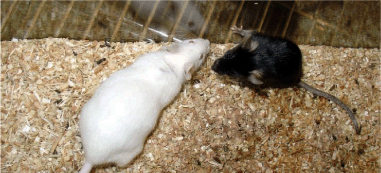
After daily exposure for ten days to a larger belligerent mouse, subject mice retain withdrawn behavior in the company of ordinary mice, and they retain altered brain chemistry, for weeks. The chemical agent held accountable is active in addiction chemistry and an aspect nerve growth linked to anti-depressive medicines. The mice with the induced syndrome responded to prozac.
....................
From the journal Science, Feb. 10, 2006
News of the Week
NEUROSCIENCE:
Bullied Mice Implicate Brain's Reward Pathway in Mood Disorders
Constance Holden
Chronic bullying and intimidation can make a person--or a mouse--fearful and withdrawn. Now scientists have shown in bullied mice that the brain's reward circuits--the areas usually associated with addiction--play a big role in these reactions. Furthermore, they find that such negative responses are enabled by brain-derived neurotrophic factor (BDNF), a chemical that elsewhere in the brain is associated with antidepressant actions.

Cowed mouse. After being bullied by a bigger mouse, mice experience brain changes that increase their fear of unfamiliar mice
On page 864, a team led by neuroscientist Olivier Berton at the University of Texas Southwestern Medical Center in Dallas reports the results of experiments in which they exposed individual mice to a different, big bully mouse every day for 10 days, creating strongly aversive behaviors in the victims. Unlike typical mice, the cowed mice act frightened even when caged with an unfamiliar, nonbully mouse. The changes were long-lasting: The "defeated" mice maintained their phobic reactions even 4 weeks after exposure to the aggressors.
Subsequent experiments showed that the bullied, fearful mice had an altered mesolimbic dopamine system, the brain pathway best known for reinforcing addictive behavior through the release of dopamine. "This social-defeat process induced [production of] BDNF in the reward circuit," says the senior author, psychiatrist Eric Nestler.
BDNF stimulates nerve cell growth, and it is hypothesized that some antidepressants work by boosting BDNF production, leading to the growth of new neurons in the hippocampus. But Nestler's team found that in the areas comprising the reward circuit, the bullying-induced BDNF facilitates long-term neuronal changes that cause the development of social aversion, a common symptom of depression. When they injected mice with a virus that knocks out BDNF production solely in this circuit, the mice were no longer intimidated by the bullies.
Although the reward neural circuit is of intense interest to addiction researchers, Nestler's group concludes that it also plays a part in depression, social phobias, and even posttraumatic stress disorder. "This paper for the first time establishes an important role for BDNF in a brain circuit that clearly is involved in a host of devastating neuropsychiatric disorders" besides addiction, says psychiatrist Robert Malenka of Stanford University in Palo Alto, California.
Malenka notes that the brain's reward system has been slighted in research on emotional disorders even though "it's kind of intuitive" that those pathways would also be involved in depression, because inability to experience any rewarding feelings is a hallmark of depression. This work, he says, "puts BDNF in the dopamine system front and center" in disorders involving emotional withdrawal.
In the hippocampus, BDNF is associated with learning and memory. With the new study, says Nestler, the chemical is now "implicated in a different nerve circuit, playing a role in a different type of learning: [long-term] social learning." Harvard psychiatrist Steven Hyman, a former director of the National Institute of Mental Health, points out that this is another instance of brain chemicals' functions being dependent on their location. And by highlighting the importance of BDNF and the mesolimbic dopamine system, he says, the new study is "one more salient reminder that reward systems, too long neglected, are likely to play a critical role in mood regulation."
Hyman agrees with Nestler that the mouse study suggests that the brain's reward circuitry is a new target for drugs treating human mood disorders. The results also indicate that the stress from chronic anxiety may be treatable by antidepressants, says Nestler. He notes that although tranquilizers normally help alleviate acute anxiety, benzodiazepine had no effect on the bullied mice, whereas fluoxetine (Prozac) had the same effect as deleting BDNF.